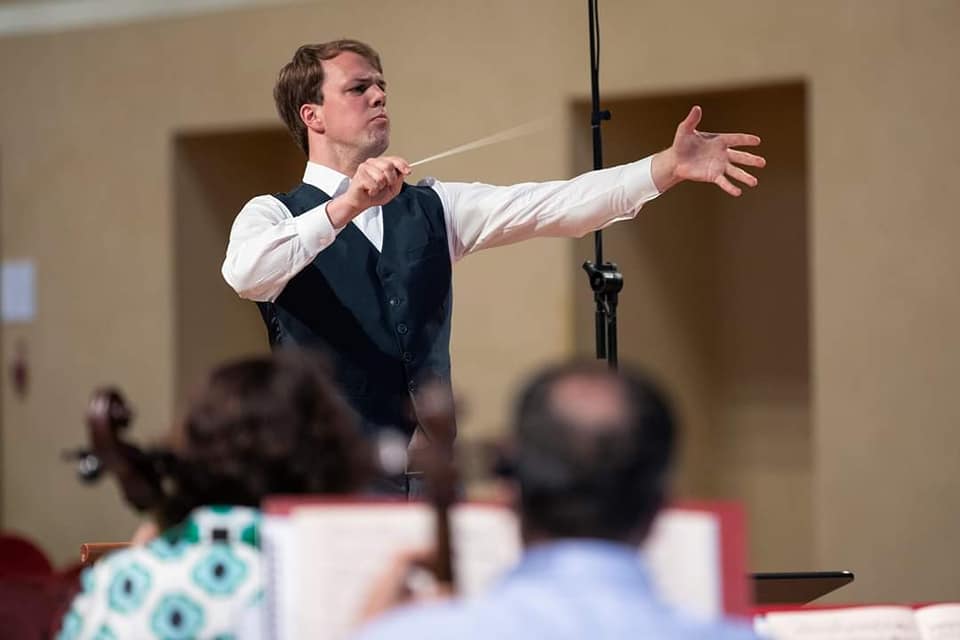Two scientists pronounce singing in church to be Covid safe
mainProfessor Christian Kähler and Dr Rainer Hain from the military university in Munich have been conducting experiments with singers and orchestral musicians to determine whether their activities can spread the Coronavirus.
The initial results from the Institute of Fluid Mechanics and Aerodynamics are encouraging.
Air was only set in motion no more than half a metre in front of the mouth, making virus spread beyond that ‘extremely unlikely’, according to the study leaders. Kähler nonetheless recommended a 1.5 metre safety cordon in a choir or church of 1.5 meters, as well as distancing between singers to prevent droplet infection.
For trumpet and trombone and euphonium, the air-motion was again half a metre. But clarinet, oboe and bassoon moved the air more than one metre and flutes reached an even greater range. The recommendation was that flutes should be played with a gauze over the outlet.
These are initial findings, translated from the German, and they are not definitive.
But they are encouraging for the eventual resumption of musical activity.
See earlier: Berlin scientists issue new rules.






Half a meter sounds like around two feet, but did they consider the density of people standing next to each other in a choir? The lateral travel would certainly be sufficient to cause contagion, as has been proven.
I don’t think they were talking about any choir singing but simply a congregation singing bog -standard hymns at 6 feet / 2metres apart!
No, Maria, they specifically mention orchestras and choirs I think. But it’s not impossible to space choral singers in this way, just very inconvenient! Also goes against the wonderful ‘togetherness’ that singers experience, which is a lot of the attraction and pleasure of it.
singing pianissimo, perhaps! I want to believe it but don’t.
I agree. Did the study take into account the effect of consonants (fricatives, plosives), or did it only deal with sustained tones? Most of the droplet production and propulsion will occur in enunciating certain consonants, and one only need watch actors on stage to see how far macroscopic droplets travel under such circumstances, let alone smaller ones.
All this will become more or less academic, once therapeutics and vaccines are available… until the next zoonotic virus pops up.
There will likely be a very long wait, if you want to wait for a vaccine. Researchers have been attempting to create a vaccine for SARS (quite close to Covid-19) for nearly 20 years and haven’t managed to create one yet.
We will have herd immunity much sooner than any vaccine.
Might need to design new masks especially for singers and other performers complete with fitted microphones in this post-Covid society…….
Please refer back to reports of the initial outbreak in Washington State: most members of an amateur chorus developed symptoms of COVID-19 infection following a scheduled rehearsal. This event occurred at about the time that the Life Care nursing home outbreak was reported. Epidemiologic analyses of the choral activities implicated viral spread among the singers via droplets exhaled by infected singers, thus exposing their fellow chorus members to the virus. Previously asymptomatic individuals became ill within a few days after the rehearsal. All performing organizations should be cautious as they consider resuming their schedules.
Hoping this would be a temporary stop-gap measure.
not all the singers in the choir should be mic’d…
How quick you forget:
https://slippedisc.com/2020/03/this-choir-practice-may-have-cost-lives/
The infamous church choir incident in the US seems to contradict these findings but maybe there’s a detail I’m missing.
I’ve heard of no other choir members in the country dying because of catching the virus in a rehearsal have you? Unless you believe that no other choirs in the country had choir rehearsals on that date or later, or you believe that in those other rehearsals there was no person who had the virus (current studies suggest that at least 25% of those with no symptoms who are tested end up being positive), unless you believe all of that, the situation in that choir while tragic is nothing more than another anecdotal point to consider and certainly not as definitive as this kind of research. At least that’s what logic tells me.
Er…not sure what your “25 percent are positive” comes from. BUT…
Many people have Covid-19 without symptoms or very mild symptoms. In the worst hit areas it is likely that 25 percent of the population has already caught the virus (we can’t be sure since we have not tested the population for this, but this would be a reasonable estimate).
This choir: Of 130 members, 102 fell ill, 4 fatalities. The Amsterdam Mixed Choir had normal practice Feb 25. On Feb 27 Netherlands had first confirmed Covid-19 case. After several rehearsals, members were calling in sick. By the Mar 8 concert, 30 called out sick, with 70+ more soon after. Article in German. https://www.trouw.nl/verdieping/die-ene-passion-die-wel-doorging-met-rampzalige-gevolgen~b4ced33e/?referer=https%3A%2F%2Ft.co%2FQWOn8Cut25%3Famp%3D1#&gid=1&pid=2
The suggestion is that it was not the singing per se that caused the spread, but the other normal activities of a large choir getting together. One of the members said that they were a very tactile group – lots of hugs, touching, handing out of chairs, small group chats etc. There have now been other experiments that replicated the above findings.
So this never happened then?
https://www.google.co.uk/amp/s/www.latimes.com/world-nation/story/2020-03-29/coronavirus-choir-outbreak%3f_amp=true
Yeah, this sounds like a garbage study, to be honest. It’s the news all want to hear, but it is at odds with every other study on the subject. Seems like they may want to get their work reviewed by others in the field.
How far do screaming maestros (ahem, Toscanini) project their air?
It’s immaterial what they think, because the proof is in the pudding. There was a youth choir in the U.S. that tried that, and darn near the whole choir got sick from it. I believe that was in Washington state. There are different strains of Covid and some are extremely contagious. What’s the point of taking the risk.
Er…the differences between the different strains are very small. And they are more-or-less similarly contagious.
One choir rehearsal. 60 singers. 45 tested positive in following weeks. 2 dead.
https://www.google.co.uk/amp/s/www.latimes.com/world-nation/story/2020-03-29/coronavirus-choir-outbreak%3f_amp=true
Of course it happened. But that’s the same choir as Mentioned in Eleanor’s post on May 8. I still have heard of only 1 choir in the nation having this happen. Now with Peggy’s research (as best I understand her post…I don’t read German (I couldn’t follow the article), we have 1 choir in Europe with 100 illnesses and 4 deaths. That makes a world wide total of 2 choirs with a total of 5 fatalities due to catching something in choir.
Where are the others? Where are all the other choirs some of whose members became sick and died. Surely there have to be hundreds for us to all quit singing. It doesn’t mean it didn’t happen, just that we don’t know.
Sorry, 1 or 2 examples does not a pattern make for me. If there were a total of 10 choirs rehearsing in the world during that time each with 100 singers, what we’ve seen so far would be 5 death’s per 1000 (.5%) and roughly 110 made sick (10%). That percentage would be enough to be alarming for me.
But we have many, many more choirs than that in America. How many choirs do we have in the nation or for that matter in the world (we should consider the world, if we are going to include world wide sicknesses from choir singing). A quick bit of research estimates 100 million choral singers world wide. If the average choir size is 100, that would be 1 million choirs in the world. How many of them were still rehearsing during that time? If only 1/10th of them were still rehearsing that would amount to 4 deaths in 100,000 choral singers. Those are all just estimates with no basis in research. I just don’t have the time. But I did look up that I have a 1 in 77 chance of dying in a car crash on my way to rehearsal, so a 1 chance in 25,000 of dying due to a virus is just not enough or me.
I don’t know what happened to the choir in the Mount Vernon Presbyterian Church, and I don’t know what happened in the Mixed Choir in Amsterdam. What’s more I don’t know if they were the only choirs rehearsing during that time frame. If they were, we are right to respond they way we have. But I simply don’t believe they were.
I am speaking only for myself, but I don’t have enough data yet. What data I do have is woefully insufficient for me to justify the response that we have chosen.
I am a church choir director in the United States. Before our state imposed bans on gatherings and strict social distancing, I cancelled choir rehearsal. Most other choirs in my area cancelled rehearsals. This was done before there were any confirmed cases in our area (10 mile radius), no deaths in our state, and only a handful of confirmed cases 40 miles away.
In addition, there is not a strong, sustained program for contact tracing in the USA. We wouldn’t have access to that type of data.
Just my experiences.
I agree, Terry, that the data is insufficient, but more and more data is surfacing that should cause us to at least pause: video research of airborne particles caused by speaking, research into viral clouds of sneezes and coughs, and then an older study that shows a 30 second sustained sung “aahh” puts out as many particles from our lungs and throats as 30 seconds of continual cough. Yikes! More and more clusters share a common trait: singing. At the Austrian Alps superspreader event, a video surfaced of many in a bar singing Highway to Hell at the top of their lungs. This was a bar many future Covid people visited. And more choirs (need Google Translate for some!) March 9 Netherlands Men’s Choir Practice 80 members: 32 positive, 6 died. March 9 Berlin Cathedral Choir rehearsal 80 singers –one was positive. Within 2 weeks, 30 positive, 30 with symptoms. And just recently, maybe the most disturbing: May 10 Frankfurt, Germany Church: 180 attended, 112 cases. They followed the proper distancing, and sanitizing, but sang and didn’t wear masks, so it APPEARS it wasn’t from touching something or from close contact, hugs, etc. I’d love to believe the air movement data these two men brought up, but the research data from studies of various sizes of particles seems to be pointing to singing, coughing, and sneezing all being good at aerosolizing tiny particles that can stay aloft. It’s heartbreaking news, but with this new knowledge, maybe we can attack the problem and come up with solutions, like UV lights in choir lofts, hepa air filters, etc., so we can get back to singing soon.
It is insane that this is covered by this website, but the recent webinar hosted by ACDA, NATS, Barbershop et al – which found conclusions in direct opposition to these findings – is not mentioned.
Read more: https://acda.org/resources-for-choral-professionals-during-a-pandemic/
I wonder if those aGerman army scientists know about what happened in Washington state in March …
https://www.latimes.com/world-nation/story/2020-03-29/coronavirus-choir-outbreak
It’s fine for research to be contradictory and we have to keep gathering data, but I think these guys are going out on a big limb here.
Flutes should be played with gauze over the outlet? Has anyone tried this? I imagine it would be an effective way of disguising one’s sound, like putting a handkerchief over the phone receiver.
What, and three people to a pew?
Singers don’t read music, they read lyrics.
They get to do both!
All of the people I know who got infected are singers or choir directors. I know that’s anecdotal, but still. Some scientists are saying that the aerosols can travel beyond 2 meters and linger for a couple of hours, that’s a significant viral load in a rehearsal. Here’s another view: https://www.middleclassartist.com/post/nats-panel-of-experts-lays-out-sobering-future-for-singers-no-vaccine-no-safe-public-singing?fbclid=IwAR0O7WgGKVYvulFrkuARUlbOdcCFzFJoA8Ws2qW89Ftm7P7P_nuGpurdBGo&postId=5eb20e9e3309a500179c30ce
Hang on. This seems to say that singing or playing an instrument has little risk. But doesn’t it miss the point that infected people may sneeze or cough, which is the main mechanism for virus to be transmitted. The two metre separation is to protect us against coughing, not against singing.
When you breath or speak/sing, you will produce small droplets in the air. Coughing and sneezing just produces larger and more droplets. If you are with other people, you should try to ventilate the space you are in.
Gauze over the “outlet”? Woodwind instruments have a series of keys and finger holes. Air only comes out of the end of a flute or clarinet for example when all the keys and holes are all closed, which is a small portion of the time.
Hi Phil,
The flute’s mouthpiece has no resistance, therefore approximately 50% of the breath goes over the embouchure hole and into the room. The other 50% travels into the tube. As each key opens, a small amount of air will escape the tube. Additionally, most flutes are ‘open hole’ meaning that the tops of 5 of the keys have been hollowed out to facilitate faster airflow, resulting in better pitch and immediacy of resonance. Very little air actually flows out of the end of a flute, the most being when a low C or B are played. Compared to other wind instruments that have reeds or cupped brass mouthpieces, the breath of a flutist likely travels further than other wind instruments.
“The flute’s mouthpiece has no resistance, therefore approximately 50% of the breath goes over the embouchure hole and into the room. The other 50% travels into the tube. As each key opens, a small amount of air will escape the tube.”
This is stupid utterly unscientific bollox!
I read some clueless nonsense but this really is one of the worst.
Have you read any resonant theory whatsoever?
As a kid doing science in school even?
Flutes work in exactly the same way as organ pipes, which is why organs of course try to copy them.
They rely by confining an orifice excited by a high pressure low energy stream which sets in motion the resonance.
That automatically means very SMALL amounts of air, but high pressure.
ie. P/V = constant.
All resonant phenomena rely on a very small amount of energy to excite a (often very large) resonant space or players get exhausted very fast.
If it’s a small round linear tube, this is likely to cause a sine wave, if it’s conic or square it will be much less linear and much less like a sine, with lots of harmonics, idem brass instruments which also require small amounts of air at high pressures.
The whole point about a resonant pipe such as a flute, is almost ZERO air goes into the pipe (unless you are a beginner of course!), but if you are any good, the actual high pressure airstream is highly controlled and is extremely small….(which enables a flute player to use ONE BREATH to make a note as long as 30s!)*
Exactly the OPPOSITE of what the cranks are claiming here!
*Human voices have a similar effect caused by the extremely small vocal chords (high pressure resonance) amplified by the mouth and pinna.
However, human devices are less efficient than mechanical ones, which is why running is bound to be less efficient and slower than cycling.
Assuming something is lost in translation here. As a flutist, I can assure you that “a gauze over the outlet” makes no sense whatsoever. There isn’t an “outlet” for air with a flute, and anything that disturbs the flow of air also ruins, essentially deletes, the sound entirely. A barrier around the front of the flutist to protect others is conceivable.
As for brass players I would be more concerned about the quantity of saliva that ends ho on the floor. They have to constantly empty the ” water” which is really saliva. There are usually small puddles where the brass players sit. Not to mention that saliva also can exit from the mouth corners. This would put their colleagues at risk moreso than the public.
Looks absolutely pathetic, yet again supported by the same band of “experts” who got us into this mess in the first place.
When ever did singing in a church with modern ‘elf and safety” ever constitute a parallel to the routine deadly diseases Chopin, Schubert, Bartok and many others died of?
Hmm… Try this: https://www.latimes.com/world-nation/story/2020-03-29/coronavirus-choir-outbreak
And there are other equally sad reports of the virus spreading in choirs even though they socially distance.
I’m a professional mezzo-soprano and I am a certified C2 level German speaker (mastery). I’d like to provide more translation for you all. This is a fairly quick translation, use at your own risk:
1. The title of the article is “Infection Risk in Choir Singing Limited.” Nowhere in the title or initial description is the word “safe” used.
2. After the 1.5 meter distance mention (which includes staggered positioning of the singers), there is another sentence that states: “For a safe music-making endeavor, the size of the room and good ventilation are also important.”
3. The reference to cloth is not specifically to gauze, but to a “very thin and densely woven cloth.”
4. The final subtitle is “Crosswind is dicey.” The paragraph reads: “For making music outside the researchers see danger only in the case of a light and consistent crosswind. This could carry the contaminated air over a larger distance. The researchers suggest a brass group in a Biergarten should use a low volume. Otherwise people who would like to converse might get even closer to one another and speak louder, which would also increase the danger of infection.”
To fully understand the text of this article, I recommend contacting the Catholic Media Center and requesting use of their article as well as an official English translation, if they have it.
ACDA’s southern region convention began the day after the infamous choir rehearsal in Washington state. From March 11-14, dozens of choirs performed there.
Here is a video and the report:
https://youtu.be/BYo3wlWUDDM
https://www.unibw.de/lrt7-en/making_music_during_the_sars-cov-2_pandemic.pdf
I would love to read this whole paper by Kahler and Rain as I work with musicians – can you help me to find it?
Understandably, worldwide, musicians are concerned about what the pandemic means for their art and livelihood.
The problem with the conclusions drawn from the research cited in this post is that it only accounts for the initial movement of air from the act of singing. If the aerosolized droplets from singing traveled 0.5 meters and immediately fell to the ground then one might conclude (as the authors do) that virus spread would be extremely unlikely. If this were the case then it is unlikely there would be a pandemic because then self-inoculation from surface to hand to face would be the main source of transmission. In this case, cleaning surfaces, careful hand hygiene, and avoiding touching ones face would virtually eliminate the risk of contracting the disease. However, the post does not take into account that the droplets can remain airborne for 8 to 14 minutes. Unlike avoiding touching one’s face, one cannot avoid breathing. Respiratory droplets remain a likely mode of person-to-person transmission of SARS-Cov-2. https://www.pnas.org/content/early/2020/05/12/2006874117